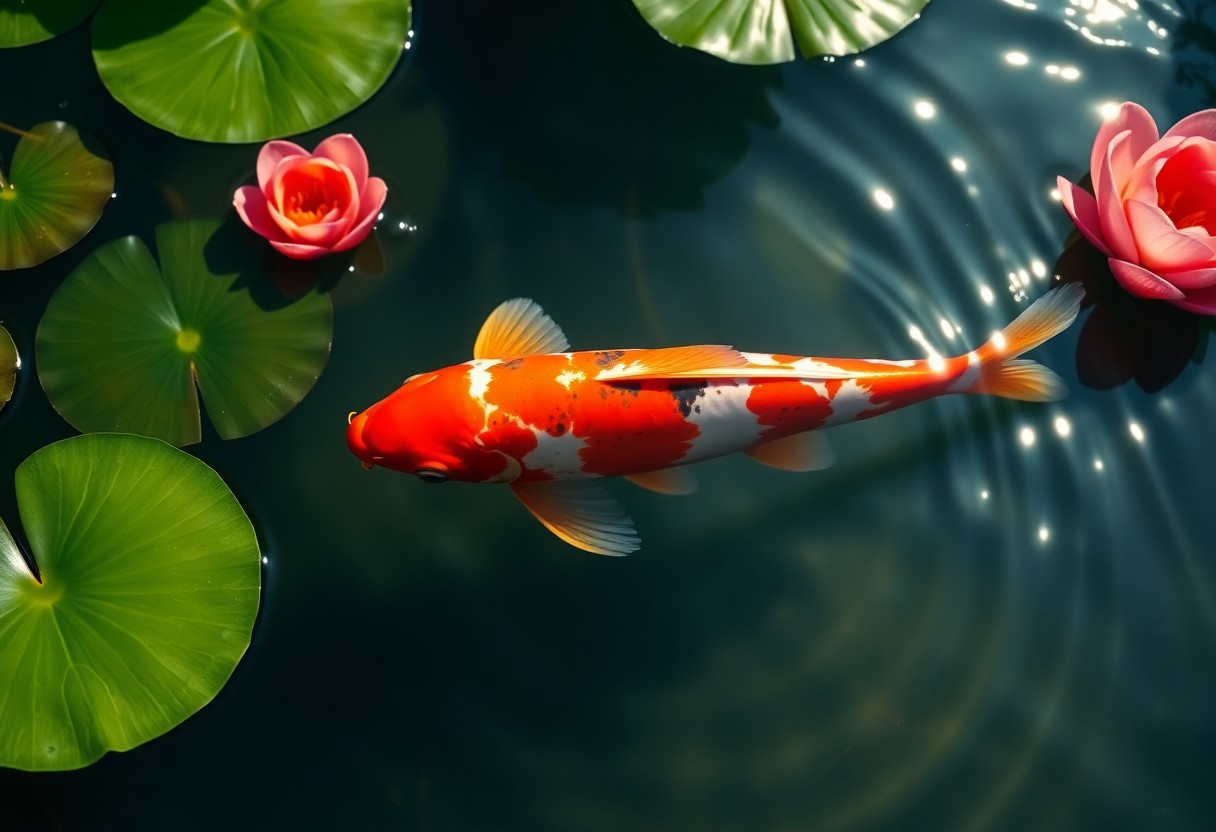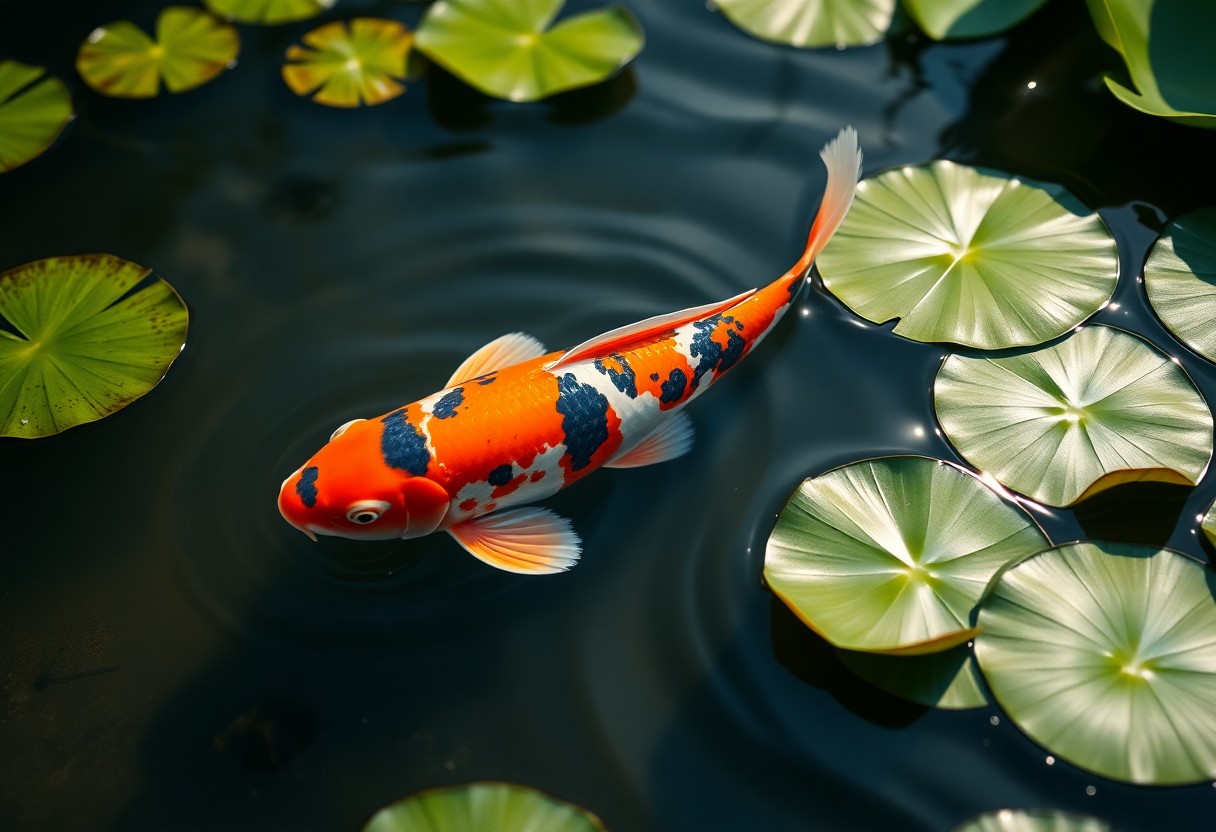Many people wonder about the possibility of consuming koi fish, given their vibrant colors and popularity as ornamental pets. You should be aware that koi are not typically raised for food and may pose health risks if consumed due to potential contaminants. However, koi fish can be eaten, especially in certain cultures. It is important to consider the sourcing and preparation methods if you choose to explore this culinary option. Understanding these factors can help you make an informed decision about whether to include koi in your diet.
Table of Contents
Key Takeaways:
- Koi fish are primarily bred for ornamental purposes and are not typically raised for consumption.
- There are health considerations, including the risk of parasites and toxins in koi, making them unsafe to eat unless properly prepared.
- Koi are often kept in ponds with varying water quality, which can affect their safety as food.
- The cultural significance of koi in many societies emphasizes their role as symbols of beauty and prosperity rather than food sources.
- If considering consuming koi, it’s crucial to consult with experts regarding their preparation and safety guidelines.
Understanding Koi Fish
For many enthusiasts, Koi fish are not just ornamental pond dwellers but also represent tranquility, beauty, and tradition. They are often bred for their vibrant colors and distinctive patterns, contributing to their popularity in Japanese water gardens. Understanding Koi involves appreciating their history, care, and their role in aquaculture.
Origin and Cultural Significance
One significant aspect of Koi fish is their origin, tracing back to ancient China and Japan. Initially bred for food, these fish evolved into symbols of perseverance and strength in Japanese culture. Cultural practices, such as Koi competitions, highlight their importance and the admiration they inspire.
Difference Between Koi and Common Carp
At first glance, Koi fish and common carp may appear similar, but distinct features set them apart. Koi are selectively bred for their vibrant colors and patterns, while common carp tend to be less colorful and have a dull appearance. Additionally, Koi typically have a more elongated body and can grow larger than common carp.
Significance in differentiating Koi from common carp lies in their breeding and purpose. Koi are highly valued in the ornamental fish market, which drives selective breeding for specific colors and patterns. This process results in a more aesthetically pleasing and usually more expensive fish. In contrast, common carp are primarily targeted for fishing and aquaculture rather than ornamental purposes. Understanding these differences can help you appreciate the commitment and care involved in raising and maintaining Koi, as well as their role in both art and culture.
Edibility of Koi Fish
There’s a common misconception that koi fish are unsuitable for consumption due to their ornamental status. However, many people question Are Koi fish good for cooking and eating? Do any restaurants serve them? Indeed, koi are technically edible, but they are not commonly considered a culinary choice. Generally, they’re valued for their beauty and symbolism rather than as a food source, leading many to overlook their potential edibility.
Nutritional Value
The nutritional value of koi fish aligns with that of other freshwater fish, providing necessary proteins, vitamins, and minerals. Though not widely consumed, their flesh is rich in omega-3 fatty acids and can serve as a healthy protein source if prepared properly.
Safety Considerations
With koi fish being primarily ornamental, safety precautions are important if you consider consuming them. It’s vital to ensure that the fish are raised in clean, chemical-free environments to avoid potential toxins. Moreover, since koi can carry parasites, proper cooking methods should be employed to eliminate any health risks.
Considering koi fish for consumption raises several safety concerns. Ensure that the koi are sourced from reputable farms that practice safe and ethical breeding. Avoid fish that have been exposed to harmful chemicals or pesticides, as they can accumulate in the flesh. Furthermore, always cook the fish thoroughly to eradicate any potential parasites. While koi can be eaten, your health and safety should always take precedence.
Traditional Consumption
Now, while Koi fish are best known for their beauty and symbolism in Japanese culture, they have also been part of a traditional diet in some regions. Cultural practices have occasionally embraced these ornamental fish not just as pets but as a source of food, particularly in times of scarcity. Their rich, flavorful flesh can be prepared in various ways, overshadowed by mainstream types of fish.
Historical Practices
Before Koi became cherished garden ornaments, various cultures utilized them as a protein source. They were often featured in religious ceremonies and feasts, demonstrating their dual purpose in society—as both a creative expression and a practical food resource.
Modern-Day Usage
Historically, Koi were a staple in certain diets, but today’s practices are less common. In contemporary dining, you may find Koi fish on menus in specific cultural contexts, reflecting a blend of globalization and tradition while still remaining an uncommon choice.
In addition to their historical roots, Koi fish are now being occasionally incorporated into gourmet dishes by some adventurous chefs. Their unique flavor profile can be highlighted in various recipes, making it a *novel and intriguing option* for food enthusiasts. However, you should exercise caution, as not all Koi are raised for consumption and could contain potentially *harmful substances due to improper farming practices*. It’s wise to source your Koi from reputable providers to ensure your meal is *safe and sustainable*.
Legal and Ethical Considerations
All discussions surrounding consumption of koi fish involve significant legal and ethical considerations. Many regions have laws protecting koi due to their cultural significance and role as symbols of prosperity. Before considering koi for consumption, it’s vital to check your local How To Feed Your Koi Like Japanese Champions! regulations to ensure compliance and respect for the species.
Regulations and Restrictions
Any attempt to consume koi should start with a thorough understanding of your local regulations. Many jurisdictions categorize koi as ornamental fish, thus prohibiting their sale or consumption. It’s vital to consult local wildlife and food safety authorities to avoid any legal repercussions.
Cultural Sensitivities
Restrictions on koi consumption also arise from cultural sensitivities. Legal frameworks often reflect societal values that regard koi as sacred or significant. In various cultures, these fish symbolize good fortune and are often treated with utmost respect. Consuming koi can be perceived as disrespectful, and it’s important to consider how this may affect your relationships with others in your community.
Legal implications surrounding koi consumption can be vast and intertwined with cultural norms. Different communities may hold koi in high esteem, making any attempt to eat them not only a legal infringement but potentially offensive. Being aware of these socio-cultural intricacies allows you to navigate this topic more sensitively, maintaining harmony with your surroundings while respecting the traditions associated with these beautiful fish.

Alternative Food Sources
Keep in mind that while Koi fish are generally not consumed, there are other viable food sources available for those looking for alternatives. Fish such as salmon, tilapia, and catfish are excellent options, offering a rich source of protein and Omega-3 fatty acids without the need to turn to Koi. Exploring these different species can provide you with various flavors and nutritional benefits, enhancing your diet without compromising your values.
Common Carp Species
On the topic of edibility, it’s important to note that common carp are often consumed in various cuisines around the world. They are known for their mild flavor and are typically prepared in stews, grilled, or smoked. Understanding the preparation techniques can help you appreciate the unique taste of this freshwater fish.
Sustainable Options
Carp fishing in many regions is becoming a sustainable choice, emphasizing responsible consumption practices that protect marine ecosystems. You have the opportunity to choose fish that are raised or caught with mindfulness toward environmental impacts, promoting healthier ecosystems and communities.
Also, opting for sustainable fish helps in maintaining fish populations and supports local economies. When purchasing, you can seek certifications like the Marine Stewardship Council (MSC) or Aquaculture Stewardship Council (ASC) to ensure that your choices align with sustainable fishing practices. Ultimately, by choosing responsibly sourced fish, you can contribute positively to the environment while enjoying nutritious meals.
Economic Impact
Many factors influence the economic impact of koi fish, particularly in markets where they are prized. The ornamental fish trade generates significant revenue, contributing to local economies through sales and associated activities, such as pond building and maintenance. Furthermore, the multi-billion-dollar koi industry promotes tourism, as enthusiasts travel to specialty farms and events, further supporting local businesses.
Value as Ornamental Fish
About 90% of koi fish sold are valued for their ornamental beauty, with some specimens fetching thousands of dollars. Their unique patterns and vibrant colors make them highly sought after for private and public displays, enhancing property aesthetics and even contributing to increased real estate values.
Cost Comparison with Food Fish
On average, the price of koi fish compared to typical food fish shows a remarkable difference. The following table outlines this comparison:
Cost Comparison of Koi Fish vs. Food Fish| Type of Fish | Average Price per Pound |
|---|---|
| Koi Fish | $30 – $100+ |
| Common Food Fish (e.g., Salmon) | $10 – $15 |
It’s evident that koi fish hold a remarkable price premium due to their ornamental value, while common food fish are typically more affordable. The investment in koi also relates to their lifespan and ongoing care, which can further elevate their value. While you may enjoy the flavor of food fish, koi are primarily regarded as collectible and decorative, ensuring that your choices in the fish market reflect your personal interests and preferences.
Conclusion
Summing up, while Koi fish are technically edible, it is generally not advisable to consume them due to their significance in culture, potential toxicity, and the fact that they are often kept as ornamental pets. If you are considering eating fish, you might want to opt for species specifically bred for culinary purposes. Your choice will ensure a more enjoyable and safer dining experience.
FAQ
Q: Can koi fish be eaten?
A: Yes, koi fish can be eaten as they are a type of carp. However, they are usually considered more decorative pets rather than a food source. It’s important to ensure the koi is sourced from a safe environment and is free from contaminants or chemicals before consumption.
Q: Is koi fish safe for human consumption?
A: While koi are technically safe to eat, they are not typically consumed due to their role in ornamental aquaculture. Additionally, koi are often raised in environments that may expose them to harmful substances. Consuming koi from dubious sources could pose health risks, so it’s important to know the origin of the fish.
Q: How does koi fish taste compared to other fish?
A: Koi fish can have a taste similar to other carp, which may vary depending on their diet and living conditions. The texture and flavor might not be as appealing compared to other more popular fish like salmon or tuna. If considering eating koi, it may be best to prepare it in a way that enhances its flavor.
Q: Are there any specific recipes for cooking koi fish?
A: There are no widely known recipes specifically for koi fish, as they are not commonly eaten. However, traditional carp recipes can be adapted for koi. Common methods include grilling, frying, or making soup, often seasoned with complementary spices and herbs to enhance the fish’s natural flavor.
Q: What should I do if I want to try koi fish?
A: If you wish to try koi fish, it’s advisable to source it from a reputable fish supplier who can assure its safety for consumption. Ensure that the fish has been properly cleaned and prepared. Alternatively, consider trying other varieties of carp or fish that are known for their culinary value.

